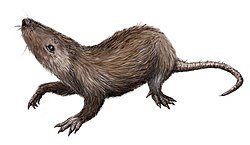| Lavocatia Temporal range: Early Cretaceous | |
|---|---|
| Scientific classification | |
| Domain: | Eukaryota |
| Kingdom: | Animalia |
| Phylum: | Chordata |
| Class: | Mammalia |
| Order: | † Multituberculata |
| Family: | † Pinheirodontidae |
| Genus: | † Lavocatia |
| Species: | †L. alfambrensis |
| Binomial name | |
| †Lavocatia alfambrensis Canudo J.I. and Cuenca G., 1996 | |
Lavocatia is a genus of extinct mammal from the Lower Cretaceous of Spain. It was a member of the also extinct order Multituberculata, and lived alongside of dinosaurs. Like most Mesozoic mammals, it was a shrewish-sized animal. It's in the suborder "Plagiaulacida" and family Pinheirodontidae. The genus Lavocatia was named by J. I. Canudo and G. Cuenca in 1996 based on a single tooth, with the generic name in honor of French paleontologist René Lavocat and the specific epithet a reference to the town of Alfambra.
The species Lavocatia alfambrensis is known from the Barremian-age Camarillas Formation of Galve, Spain. This genus is apparently differentiated by the number of cusps on the tooth; 15. Also referred to in the reference is Peramura. This was a more "advanced" group of mammals, possibly ancestral to ourselves (see Peramus ).


